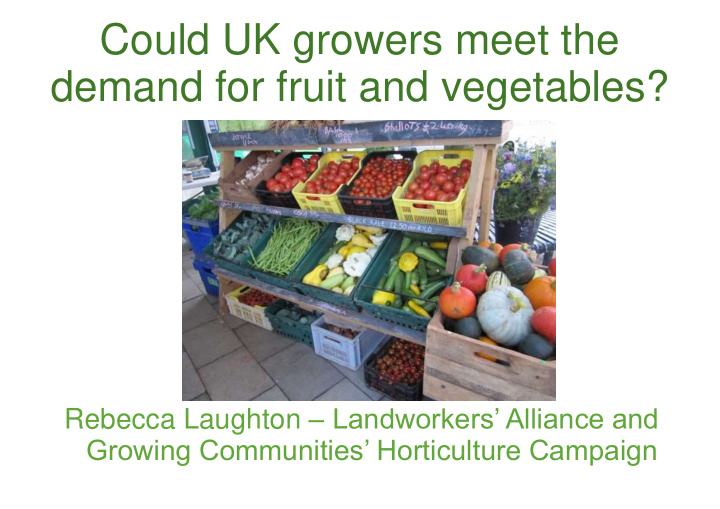



Could UK growers meet the demand for fruit and vegetables? Rebecca Laughton – Landworkers’ Alliance and Growing Communities’ Horticulture Campaign
We must make UK fruit and vegetable supply more resilient Health imperative ⚫ Labour crisis ⚫ Climate change adaptation ⚫ - Rest of world can’t be relied upon to keep feeding UK (water shortages, floods, pest and disease outbreaks) - UK may become one of fewer countries that can still grow vegetables Climate change mitigation ⚫ - Reduce long distance food transport
UK Horticultural Production(2018) Vegetables Fruit • 16.7% home produced 53% home produced ⚫ • 83.3% imported 47% imported ⚫ • Total UK production 131,000ha planted to ⚫ veg (<1% of agricultural 719,000 tonnes land) • Home produced apples 2.4 million tonnes increased market share to ⚫ 45% (from 33% in 2017) 40% lost through waste ⚫
%Domestic Production of Popular F&V = Import Substitution Opportunities Spinach 39% Peppers 10% Onions 49% Pears 16% Broccoli and cauliflower 51% Plums 17% Raspberries 56% Tomatoes 20% Beans 58% Cucumbers 24% Leeks 69% Lettuce 30% Cabbage Desert apples 31% 92% Courgettes 33%
Large Scale Veg Production - UK workers don’t want to do horticultural work - Brexit labour crisis (SAWs needs 70,000, not 2,500 workers) - Environmental impact (water, soil, monoculture) - 85% sold via supermarkets - Tight squeeze on margins
Introducing Food Zones • Direct urban • Direct peri-urban • Direct rural hinterland • Wholesale national • Wholesale Europe • Wholesale further afield
Growing Communities - An existing example in Hackney, London Routes to Market: Supplied by : 1600 weekly fruit and • 3 urban market ⚫ veg bags gardens Weekly farmers’ • 3 peri-urban farms in ⚫ market Dagenham, Lea Valley and Enfield Direct sales from ⚫ urban market gardens • 3 farms in Kent, Cambridgeshire and Suffolk • 2 orchards in Kent and Essex
Alternative Routes to Market in Rural Areas • Farmers markets • Farmer led box schemes • Community Supported Agriculture • Farm shops • Traditional greengrocers • Food hubs and other online sales
Benefits of Alternative Routes to Market (ARMs) • Localised supply and distribution • 54-100% of sale price goes to growers • Improves grower viability • New entrants attracted to this kind of horticulture • Better public engagement • Organic produce more affordable than in supermarkets (inc. “Holiday Bags”)
If all F&V that could be produced in the UK, but are currently imported, were produced in the UK, they would have a market value of £3.2 billion
Imagine if 10% of that £3.2 billion was spent in local food economies, rather than on imports ………. Can we do it?
Some serious number crunching! Total sales value of one Food Zones Unit (FZU): £1,350,000 Population of Hackney: 279,000 Population of UK: 66million One FZU per 279,000 head of population = 237 FZUs 237 x £1,350,000 = £319,354,839 This represents 10% of £3.2 billion
Big Assumptions and Big Ambitions • Uniform climate and soil quality across UK • Equal ability and willingness to buy organic produce across all regions • 237 is a lot of new Food Zones
Yes we can! • Already happening in pockets across UK • Better Food Traders will measure it and develop distribution • Landworkers’ Alliance will grow more growers!
More recommend